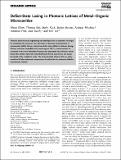Files in this item
Defect-state lasing in photonic lattices of metal-organic microcavities
Item metadata
| dc.contributor.author | Kliem, Mona | |
| dc.contributor.author | Kiel, Thomas | |
| dc.contributor.author | Kück, Malin | |
| dc.contributor.author | Meister, Stefan | |
| dc.contributor.author | Mischok, Andreas | |
| dc.contributor.author | Fröb, Hartmut | |
| dc.contributor.author | Busch, Kurt | |
| dc.contributor.author | Leo, Karl | |
| dc.date.accessioned | 2021-03-02T17:30:02Z | |
| dc.date.available | 2021-03-02T17:30:02Z | |
| dc.date.issued | 2021-02-04 | |
| dc.identifier | 271800875 | |
| dc.identifier | 8630c567-655d-43e3-8431-8491fa0bb1de | |
| dc.identifier.citation | Kliem , M , Kiel , T , Kück , M , Meister , S , Mischok , A , Fröb , H , Busch , K & Leo , K 2021 , ' Defect-state lasing in photonic lattices of metal-organic microcavities ' , Advanced Photonics Research , vol. Early View , 2000116 . https://doi.org/10.1002/adpr.202000116 | en |
| dc.identifier.issn | 2699-9293 | |
| dc.identifier.other | RIS: urn:874674CA64DDCFD28214B9921E63C376 | |
| dc.identifier.other | ORCID: /0000-0003-4725-7404/work/90112688 | |
| dc.identifier.uri | https://hdl.handle.net/10023/21540 | |
| dc.description | Funding: Deutsche Forschungsgemeinschaft (DFG, German Research Foundation) with the DFG projects Tailored Disorder SPP 1839, No. LE 747/47-1, No. LE 747/55-1, and BU 1107/10-1, as well as the Cluster of Excellence Center for Advancing Electronics Dresden. This work has been further supported by the DFG through the Würzburg-Dresden Cluster of Excellence ct.qmat (EXC 2147, project id 390858490). A.M. acknowledges funding through an individual fellowship of the DFG (404587082). T.K. and K.B. acknowledge support from the DFG –Project-ID 182087777 –SFB 951. | en |
| dc.description.abstract | Photonic band structure engineering has developed into an important technique for controlling the emission and interaction of photons and polaritons in microcavities (MCs). Herein, lasing from defect states (DSs) in photonic Kronig–Penney structures embedded into metal–organic MCs is demonstrated. As compared to the more delocalized lasing states associated with photonic bands, these DSs exhibit improved lasing thresholds that lie even below the lasing threshold of the metal‐free cavity. The characteristics of these DSs are determined via full electrodynamic computations based on the discontinuous Galerkin time‐domain method. | |
| dc.format.extent | 8 | |
| dc.format.extent | 1907347 | |
| dc.language.iso | eng | |
| dc.relation.ispartof | Advanced Photonics Research | en |
| dc.subject | Defect-state lasing | en |
| dc.subject | Microcavites | en |
| dc.subject | Organic lasers | en |
| dc.subject | Photonic confinements | en |
| dc.subject | Tamm-plasmon-polaritons | en |
| dc.subject | QC Physics | en |
| dc.subject | T-NDAS | en |
| dc.subject.lcc | QC | en |
| dc.title | Defect-state lasing in photonic lattices of metal-organic microcavities | en |
| dc.type | Journal article | en |
| dc.contributor.institution | University of St Andrews. School of Physics and Astronomy | en |
| dc.identifier.doi | 10.1002/adpr.202000116 | |
| dc.description.status | Peer reviewed | en |
This item appears in the following Collection(s)
Items in the St Andrews Research Repository are protected by copyright, with all rights reserved, unless otherwise indicated.

